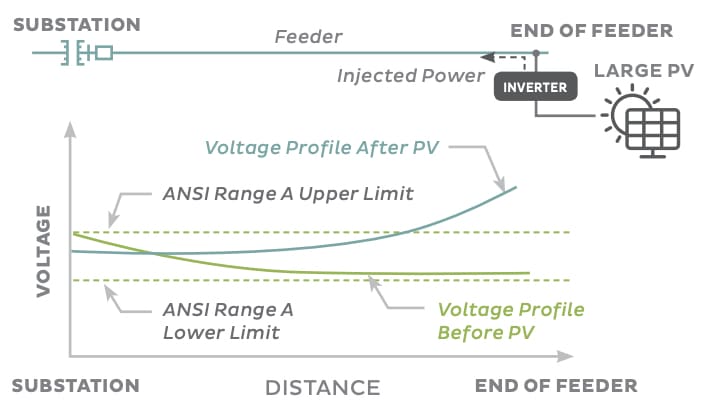We need to acknowledge the issue before we can solve it: deploying distributed PV on distribution circuits “has a voltage impact,” as illustrated in a report by the consulting firm GridLab (see the blue curve in the image above).
Utilities have regulated voltage on distribution circuits “for decades,” says the report, by using various types of hardware. Yet because the hardware on each distribution circuit has a finite capacity to regulate voltage, utilities often limit the amount of PV that may be added on a given circuit (called “hosting capacity”).
But that is changing quickly, because “advanced inverters have the potential to substantially increase hosting capacity,” according to a 2017 study by the Electric Power Research Institute, reporting findings from an Arizona Public Service test program.
Last year, the technical professional organization IEEE issued standard 1547-2018, whereby smart inverters must be able to regulate voltage (and have other capabilities). And in the next year or two, smart inverters are expected to reach the market, according to GridLab.
The next missing piece, suggests the GridLab report, is agreement on which of several possible capabilities smart inverters should use to regulate voltage. Reaching agreement on a single, best approach, and harmonizing that approach across utility and state requirements, would be beneficial for manufacturers and developers, says the report, and would streamline the interconnection process.
Educating decision-makers
The GridLab report aims to educate utilities, developers, and state regulators. In ten pages, it explains voltage regulation, reviews lessons learned in utility testing of smart inverters, and then makes its recommendations on inverter settings, for smaller “mass market” PV and PV-plus-battery systems.
GridLab says its recommendations “balance the needs of the utilities to maintain grid reliability with the needs of customers to maximize the return on their investment in their generation.”
Recommendations
GridLab’s first recommendation is to require inverters for “mass market” distributed PV to activate the “volt-var” approach (the term “reactive power” is defined in the report):
- Volt-var is able to manage voltage using the least reactive power, and is the most flexible setting.
- Even in grids with low penetrations of distributed energy resources (DER), using this setting today reduces the need to change systems in the future.
- Deployment of DER will have interactions with existing voltage regulation equipment, and utility experience to date demonstrates that volt-var settings have worked with existing equipment.
- We recommend that owners and developers consider oversizing inverters to allow required reactive power output without affecting real power production.”
An inverter with the volt-var setting activated also operates without directions from the utility, said GridLab Executive Director Ric O’Connell in an interview. “If the voltage changes, the inverter does what it’s supposed to do,” he said. That avoids the need for utility investment in both a communications system conveying signals to DERs, and a distributed energy resource management (DERM) software system to initiate signals to DERs, he added.
Both California’s Rule 21 interconnection standard and Hawaiian Electric Company require activation of volt-var with reactive power priority, the report says.
For the engineers among us, here is the text of the first recommendation:
That utilities adopt the IEEE Standard 1547-2018 default settings for volt-var with reactive power priority along with performance category B [volt-var settings] for distributed energy resource (DER) inverters.”
The report’s second recommendation—which Mr. O’Connell predicted would be more controversial—is that “volt-watt be enabled” because it “can provide a significant ‘backstop’ for voltage events.” That backstop “should increase the hosting capacity of distribution circuits, as well as eliminate the need for utilities to directly control distributed generation to mitigate voltage issues.” Specifically, the report recommends volt-watt “with a curve that would only start to curtail outside of the ANSI range (1.06 pu).”
California’s Rule 21 now requires volt-watt activation, while Hawaiian Electric Company offers volt-watt activation as an option for customers who would otherwise be required to pay for an interconnection review or system upgrades, the report says.
The report notes that PV systems larger than mass-market systems “may need more customized settings.”
The report, titled Regulating Voltage: Recommendations for Smart Inverters, was written by Ric O’Connell of GridLab, Curt Volkmann of New Energy Advisers, and Paul Brucke of Brucke Engineering. GridLab is a nonprofit energy transformation consulting firm.
This content is protected by copyright and may not be reused. If you want to cooperate with us and would like to reuse some of our content, please contact: editors@pv-magazine.com.








By submitting this form you agree to pv magazine using your data for the purposes of publishing your comment.
Your personal data will only be disclosed or otherwise transmitted to third parties for the purposes of spam filtering or if this is necessary for technical maintenance of the website. Any other transfer to third parties will not take place unless this is justified on the basis of applicable data protection regulations or if pv magazine is legally obliged to do so.
You may revoke this consent at any time with effect for the future, in which case your personal data will be deleted immediately. Otherwise, your data will be deleted if pv magazine has processed your request or the purpose of data storage is fulfilled.
Further information on data privacy can be found in our Data Protection Policy.